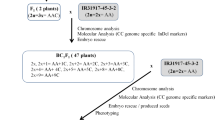Summary
Sterile AC hybrids between cultivated Oryza sativa (AA) and a distant wild species, O. officinalis (CC), were backcross to O. sativa. Most of the BC1 progenies were allotriploid (AAC), a few were hypotriploid. AAC progenies were again backcrossed to O. sativa. BC2 progenies consisting of disomic or aneuploid individuals were examined for the presence of O. officinalis traits. Eleven different traits from O. officinalis were identified in these progenies. Segregation data in the subsequent generations suggest that these traits are monogenic in nature. Two of these genes — for resistance to BPH and WBPH — are of value in rice improvement. The extremely low recovery of recombinant progenies is in agreement with the very low amount of pairing between A and C genomes. Because of this restricted recombination, the genotype of the recurrent parent was reconstituted after two backcrosses only. Thus, the BC2 progenies look remarkably similar to O. sativa. Most of them are stable and fertile and also interfertile with other O. sativa breeding lines. Some of the BPH-and WBPH-resistant progenies are comparable in yield to the best O. sativa parents and are being evaluated as varietal possibilities.
Similar content being viewed by others
References
Bouharmont J (1962) Recherches cytogénétique chez quelques hybrides interspecifique d'Oryzae. Cellule 63:53–132 (with English summary)
Chetelat RT, Rick CM, De Verna JW (1989) Isozyme analysis, chromosome pairing, and fertility of Lycopersicon esculentum x Solanum lycopersicoides diploid backcross hybrids. Genome 32:783–790
Heinrichs EA, Medrano FG, Rapusas HR (1985) Genetic evaluation for insect resistance in rice. International Rice Research Institute, Manila, The Philippines
Jena KK, Khush GS (1986) Production of monosomic alien addition lines of Oryza sativa having a single chromosome of O. officinalis. In: Rice genetics. International Rice Research Institute, Manila, The Philippines, pp 119–208
Jena KK, Khush GS (1989) Monosomic alien addition lines of rice: production, morphology, cytology, and breeding behavior. Genome 32:449–455
Katayama T (1965) Cytogenetical studies on genus Oryza. I. Chromosome pairing of interspecific hybrid O. sativa x O. officinalis under different temperature conditions. Jpn J Genet 40:307–313
Khush GS (1984) Breeding rice for resistance to insects. Protoc Ecol 7:147–165
Khush GS, Ling KC, Aquino RC, Aguiero VM (1977) Breeding for resistance to grassy stunt in rice. In: Proc 3rd Int Congr SABRAO, Canberra, Australia. Plant Breed Papers 1[4]: 3–9
Khush GS, Singh RJ, Sur SC, Librojo AL (1984) Primary trisomics of rice: origin, morphology, cytology, and use in linkage mapping. Genetics 107:141–163
Kota RS, Dvorak J (1988) Genomic instability in wheat induced by chromosome 6BS of Triticum speltoides. Genetics 120:1085–1094
Kurata N, Omura T (1984) Chromosome analysis. In: Tsunoda ST, Takahashi N (eds) Biology of rice. Japan Scientific Societies Press, Tokyo Elsevier Amstsrdam, pp 305–320
Li HW, Chen CC, Lu Katherine CL, Wu HK, Hu CH (1964) Pachytene studies of the hybrid Oryza sativa x O. officinalis. In: Rice genetics and cytogenetics. Elsevier, Amsterdam, pp 141–142
Lin SC, Yuan LP (1978) Hybrid rice breeding in China. In: Innovative approaches to rice improvement. International Rice Research Institute, Manila, The Philippines, pp 35–51
Mangelsdorf PC (1974) Mutations. In: Corn, its origin, evolution, and improvement. Harvard University Press, Cambridge/MA; pp 133–141
Mann TJ, Gerstel DU, Apple JL (1963) The role of interspecific hybridization in tobacco disease control. In: Proc 3rd World Tobacco Sci Congr, Salisbury, S. Rhodesia, pp 201–297
Morinaga T, Kuriyama H (1959) Genomic constitution of Oryza officinalis. Jpn J Breed 9:259 (Abstract in Japanese)
Morinaga T, Kuriyama H, Ono S (1958) On the interspecific hybrid of Oryza sativa and O. officinalis. Jpn J Breed 8:189 (Abstract in Japanese)
Nezu M, Katayama TC, Kihara H (1960) Genetic study of genus Oryza. I. Crossability and chromosomal affinity among 17 species. Seiken Jiho 11:1–11
O'Mara JG (1940) Cytogenetic studies on Triticale. I. A method for determining the effects of individual Secale chromosomes on Triticum. Genetics 25:401–408
Ramanujam S (1937) Cytogenetical studies in Oryzeae. III. Cytogenetical behavior of an interspecific hybrid in Oryza. J Genet 35:223–258
Rick CM (1963) Differential zygotic lethality in a tomato species hybrid. Genetics 48:1498–1507
Rick CM (1969) Controlled introgression of chromosomes of Solanum pennellii into Lycopersicon esculentum: segregation and recombination. Genetics 26:753–768
Rick CM (1971) Further studies on segregation and recombination in backcross derivatives of a tomato species hybrid. Biol Zentralbl 91:209–220
Rick CM, Chetelat RT, De Verna JW (1988) Recombination in sesquidiploid hybrids of Lycopersicon esculentum x Solanum lycopersicoides and derivatives. Theor Appl Genet 76:647–655
Savitsky H (1975) Hybridization between Beta vulgaris and B. procumbens and transmission of nematode (Heterodera schachtii) resistance to sugar beet. Can J Genet Cytol 17:197–209
Stephens SG (1949) The cytogenetics of speciation in Gossypium. I. Selective elimination of the donor parent genotype in interspecific backcrosses. Genetics 34:627–637
Tsujimoto H, Tsunewaki K (1985) Hybrid dysgenesis in common wheat caused gametocidal genes. Jpn J Genet 60:565–578
Author information
Authors and Affiliations
Additional information
Communicated by G. Wenzel
Rights and permissions
About this article
Cite this article
Jena, K.K., Khush, G.S. Introgression of genes from Oryza officinalis Well ex Watt to cultivated rice, O. sativa L.. Theoret. Appl. Genetics 80, 737–745 (1990). https://doi.org/10.1007/BF00224186
Received:
Accepted:
Issue Date:
DOI: https://doi.org/10.1007/BF00224186




